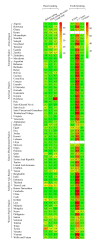Hygiene practices among young adolescents aged 12-15 years in low- and middle-income countries: a population-based study
- PMID: 33312503
- PMCID: PMC7719273
- DOI: 10.7189/jogh.10.020436
Hygiene practices among young adolescents aged 12-15 years in low- and middle-income countries: a population-based study
Abstract
Background: Poor personal hygiene increases disease risk, however, the prevalence of hygiene practices among adolescents is poorly described in low- and middle-income countries (LMICs). We aimed to assess the hygiene practices among young adolescents in LMICs using data from the Global School-based Student Health Surveys (GSHS).
Methods: This population-based study analysed the GSHS data for adolescents aged 12-15 years from 75 LMICs. Data were collected between 2003 and 2015 using standardised, anonymous, self-reported questionnaires. This report focuses on hygiene related behaviours such as tooth brushing, washing hands after using the toilet, washing hands before eating and washing hands with soap. The weighted prevalence and 95% confidential intervals (CIs) for the hygiene practices, and overall and regional estimates were calculated with random-effects meta-analysis.
Results: A total of 181 848 young adolescents from 75 LIMCs with available hygiene data were analysed. The overall prevalence for never washing hands were 7.4% (95% confidence interval (CI) = 4.4-10.3) for before eating, 5.9% (95% CI = 3.8-7.9) for after using the toilet, and 9.0% (95% CI = 6.2-11.8) for with soap. For tooth brushing, the overall prevalence estimates were 8.6% (95% CI = 5.5-11.7) for never brushing teeth, 80.9% (95% CI = 74.7-87.1) for 1-3 times per day, and 9.7% (95% CI = 5.8-13.6) for >3 times per day. However, the prevalence of different hygiene practices varied significantly among countries and regions (all P values <0.001). Poor hygiene status, with a prevalence >20%, was still observed in several LMICs (eg, 12 countries for never washing hands and 4 for never brushing teeth).
Conclusions: The hygiene practices of young adolescents aged 12-15 years were generally frequent, but poor status was still observed in several LMICs. These findings emphases the need for hygiene and health education targeting young adolescents in LMICs.
Copyright © 2020 by the Journal of Global Health. All rights reserved.
Conflict of interest statement
Competing interests: The authors completed the ICMJE Unified Competing Interest form (available upon request from the corresponding author), and declare no conflicts of interest.
Figures




Similar articles
-
Hand-Washing Practices among Adolescents Aged 12-15 Years from 80 Countries.Int J Environ Res Public Health. 2020 Dec 27;18(1):138. doi: 10.3390/ijerph18010138. Int J Environ Res Public Health. 2020. PMID: 33375506 Free PMC article.
-
Alcohol use among young adolescents in low-income and middle-income countries: a population-based study.Lancet Child Adolesc Health. 2018 Jun;2(6):415-429. doi: 10.1016/S2352-4642(18)30112-3. Epub 2018 May 1. Lancet Child Adolesc Health. 2018. PMID: 30169283
-
Hygiene behaviour and associated factors among in-school adolescents in nine African countries.Int J Behav Med. 2011 Jun;18(2):150-9. doi: 10.1007/s12529-010-9109-6. Int J Behav Med. 2011. PMID: 20593258
-
Hand-washing promotion for preventing diarrhoea.Cochrane Database Syst Rev. 2021 Jan 6;12(1):CD004265. doi: 10.1002/14651858.CD004265.pub4. Cochrane Database Syst Rev. 2021. PMID: 33539552 Free PMC article.
-
The prevalence of vitamin A deficiency and its public health significance in children in low- and middle-income countries: A systematic review and modelling analysis.J Glob Health. 2023 Aug 11;13:04084. doi: 10.7189/jogh.13.04084. J Glob Health. 2023. PMID: 37565390 Free PMC article.
Cited by
-
Individual, familial and country-level factors associated with oral hygiene practices in children: an international survey.BMC Oral Health. 2023 Jan 30;23(1):50. doi: 10.1186/s12903-023-02746-0. BMC Oral Health. 2023. PMID: 36710323 Free PMC article.
-
An outbreak of scabies in a fishing community in Hoima District, Uganda, February - June, 2022.BMC Infect Dis. 2025 Jul 1;25(1):846. doi: 10.1186/s12879-025-11208-7. BMC Infect Dis. 2025. PMID: 40597773 Free PMC article.
-
Association between receiving the Aksi Bergizi Social Behavioral Change Communication (SBCC) intervention and hygiene behaviors among secondary school students in Padang, Indonesia.PeerJ. 2025 Apr 7;13:e19256. doi: 10.7717/peerj.19256. eCollection 2025. PeerJ. 2025. PMID: 40212367 Free PMC article.
-
Multi-way modelling of oral microbial dynamics and host-microbiome interactions during induced gingivitis.NPJ Biofilms Microbiomes. 2024 Sep 19;10(1):89. doi: 10.1038/s41522-024-00565-x. NPJ Biofilms Microbiomes. 2024. PMID: 39300083 Free PMC article.
-
Sex differences in high-risk health behaviors among school-going adolescents in Yazd, Iran; a cross-sectional study.Heliyon. 2023 May 19;9(6):e16404. doi: 10.1016/j.heliyon.2023.e16404. eCollection 2023 Jun. Heliyon. 2023. PMID: 37303572 Free PMC article.
References
-
- Ejemot RI, Ehiri JE, Meremikwu MM, Critchley JA.Hand washing for preventing diarrhoea. Cochrane Database Syst Rev. 2008;CD004265. - PubMed
Publication types
MeSH terms
LinkOut - more resources
Full Text Sources
